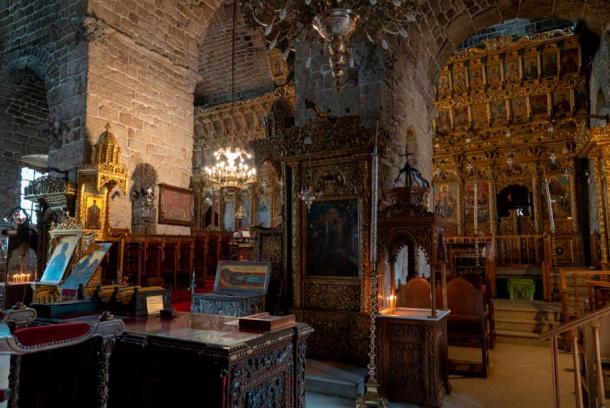
Saint Lazarus Church and the Tomb of the Man Jesus Raised from the Dead
Saint Lazarus Church (known also as the Agios Lazarus Church) is a church located in Larnaca, Cyprus. This church dates to the late 9th century, making it one of the oldest churches on the island. Saint Lazarus Church was built to house the reputed (second) tomb of Lazarus of Bethany, a Biblical figure said to have been raised from the dead by Jesus.

Inside the tomb of Lazarus.
Raising Lazarus from the Dead
Lazarus (Eleazar in Hebrew) of Bethany is a well-known figure in the Bible. He was the brother of Mary and Martha and the three of them were Jesus’ friends. The most famous narrative about Lazarus involves Jesus raising him from the dead. In this account, found in the Gospel of John, Mary and Martha sent word to Jesus that their brother was seriously ill. Jesus delayed before setting out for Bethany. When he arrived, Lazarus had been dead for four days already. Instead of mourning like the rest of those present, he had the stone rolled away from the entrance of the tomb, and called Lazarus to come out. The dead man was raised to life and many of the mourners came to believe in Jesus’ divinity.
- The Incredible History of Kolossi Castle - Won By Richard the Lionheart, Home to the Knights Templar, and Birthplace of the King of Wines
- Ancient Greek amulet with strange palindrome inscription discovered in Cyprus
- 800-Year-Old Church in Ireland Survives Viking Presence, an English Invasion and War

Illustration in the tomb of Lazarus showing Jesus resurrecting Lazarus.
Two Versions of the Story
The Bible account ends with the chief priests planning to kill Lazarus. This, however, is not the end of the story, as Lazarus and his sisters, according to tradition, managed to flee. The story then splits into two versions. According to western tradition, the Jews placed Lazarus and his sisters in a boat without sails or oars, and put them out to sea. Eventually, the three landed on the shores of Provence, France, and went to Marseille, where they began converting people to Christianity. Lazarus became the first bishop of Marseille, and is recorded to have been martyred either during the reign of Claudius or Domitian, and his body eventually came to rest in the Church of Saint Lazarus in Avallon.
Eastern tradition, however, states that Lazarus and his siblings fled to Cyprus. At Larnaca, Lazarus was appointed directly by Saints Paul and Barnabas as the city’s first bishop. Lazarus is recorded to have lived in Cyprus for 30 years, and died a second time at the age of 60. Lazarus was buried in Larnaca and the location of his tomb was subsequently lost. In 890 AD, a marble sarcophagus bearing the inscription ‘Lazarus, four days dead, friend of Christ’ was discovered in Larnaca.
- Why the Christian Idea of Hell no Longer Persuades People to Care for the Poor
- A Unique Mixture of Afro-Cuban Religious Rituals or Witchcraft? The True Story Behind Santeria
- 2,400-Year-Old Aristocrat Family Tomb Uncovered in Cyprus Sheds Light on Ancient Soloi

The coffin containing Lazarus’ remains.
Lazarus’ Relics
In 898, the remains of Lazarus were transferred to Constantinople by the Byzantine emperor Leo VI. In exchange for these sacred relics, the emperor built a church over the site where the tomb was found. The transfer is still commemorated today by the Orthodox Church annually on October17th. In 1204, Constantinople fell to the Crusaders of the Fourth Crusade and was sacked. The remains of Lazarus were taken to Marseille and later lost. But it seems that the people of Larnaca kept some of Lazarus’ relics for themselves. In 1972, whilst the church was being renovated, a marble sarcophagus was found under the altar. Inside the sarcophagus were human remains believed to be part of Lazarus’ relics.

The bones of Lazarus.
Architecture of Saint Lazarus Church
Saint Lazarus Church was built in stone and is notable for having three domes. This is one of only two three-domed churches on the island, thus making it a unique building. The original domes, however, have been destroyed. According to one account, the domes collapsed during an earthquake. A more colorful story states that when Cyprus was conquered by the Ottomans, a high ranking Turkish officer entering Larnaca knelt to pray when he saw the domes, believing the church to be a mosque. When he realized his error, he was frusurious, and ordered the domes to be pulled down.

A piece of Lazarus’ skull.
In any case, the Saint Lazarus Church became a mosque during the Ottoman period. It was a Roman Catholic Church when the island was under the rule of the Crusaders and then the Venetians. In 1589, the Ottomans sold the church back to the Orthodox Church, and Catholic services were allowed to be celebrated in the church twice a year (on the feast days of Saint Lazarus and Saint Mary Magdalene) until 1794.

Inside Saint Lazarus Church.
During the 18th century, much renovation was carried out. The iconostasis, the altar, as well as the bishop’s throne with the icon of Saint Lazarus, were all made during this time. In 1970, a fire caused damage to the church’s interior and renovations had to be carried out.
All images credit Ioannis Syrigos
Top image: Saint Lazarus Church, Larnaca, Cyprus. Source: Ioannis Syrigos .
By Ḏḥwty
References
Agios Lazaros, 2018. Holy Church of Saint Lazarus. Available at: http://en.agioslazaros.org.cy/
Cyprus Tourism Organisation, 2018. St. Lazarus Church & Ecclesiastical Museum. Available at: http://www.visitcyprus.com/files/audio_guides/written_form/St_Lazarus_afigisi_en.pdf
Dimitriou, A., 2018. Saint Lazarus Church, Larnaka. Available at: http://www.cyprusalive.com/en/saint-lazarus-church-larnaca-larnaka
New World Encyclopedia, 2018. Lazarus. Available at: http://www.newworldencyclopedia.org/entry/Lazarus
ringofchrist.com, 2018. St Lazarus – The Friend of Christ. Available at: http://ringofchrist.com/early-christian-history/st-lazarus-in-cyprus/
Sacred Destinations, 2018. Ayios Lazaros, Larnaca. Available at: http://www.sacred-destinations.com/cyprus/larnaca-ayios-lazaros
www.cyprusisland.net, 2018. Church of Saint Lazarus (Agios Lazaros) - Larnaca. Available at: https://www.cyprusisland.net/cyprus-churches/church-saint-lazarus















